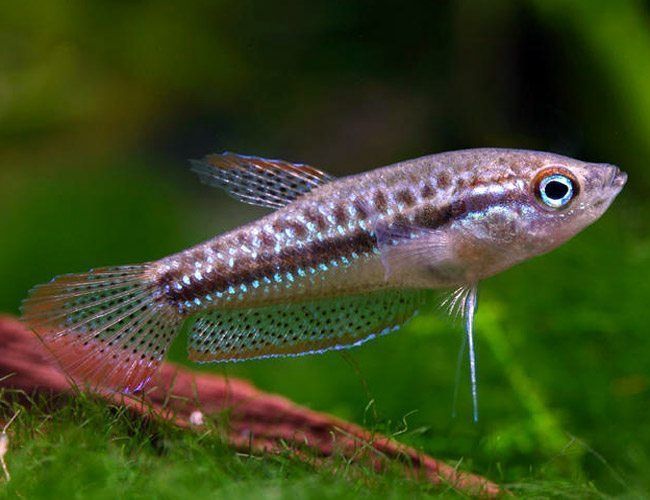Sparkling Gourami (Trichopsis pumila)
Sparkling Gourami (Trichopsis pumila)
The Sparkling Gourami (Trichopsis pumila), also known as the Pygmy Gourami, is a small, peaceful, and charming species of labyrinth fish. Known for its iridescent blue-green coloration and interesting behavior, particularly its ability to "chirp" or produce a sound, this species is a great addition to smaller, peaceful community tanks. Due to its small size and delicate nature, it’s especially suited for well-planted aquariums.
1. Tank Size
-
Because they are small fish, a 10-gallon tank (38 liters) is suitable for a group of 5-6 Sparkling Gouramis.
-
Although they can live in smaller spaces, they are social fish and do best in a group, where they can exhibit natural behaviors and feel secure.
2. Water Conditions
-
Temperature: Sparkling Gouramis prefer warm water between 75°F to 82°F (24°C to 28°C).
-
pH: They thrive in slightly acidic to neutral water, with a pH range of 6.0 to 7.5.
-
Hardness: Soft to moderately hard water is ideal, with a hardness range of 4-10 dGH.
-
Water Quality: These fish are sensitive to poor water quality, so it’s important to perform regular water changes (about 25% per week). Keep the water clean and ensure it is well-oxygenated with a gentle filter to avoid strong currents, which could stress them.
3. Diet
-
Sparkling Gouramis are omnivores, and they enjoy a varied diet:
-
High-quality flakes or pellets formulated for small fish.
-
Live or frozen foods such as brine shrimp, daphnia, and bloodworms.
-
Vegetable matter, such as blanched spinach or spirulina.
-
-
They will also nibble on biofilm and algae in the aquarium, helping to keep the tank clean.
-
Feed them small amounts 2-3 times per day, and be careful not to overfeed.
4. Tank Setup
-
Substrate: A fine gravel or sand substrate is best for Sparkling Gouramis, as it makes it easy to clean and is gentle on their delicate fins.
-
Aquascaping: They love well-planted tanks with dense vegetation and areas for hiding. Plants like Java Fern, Anubias, and Hornwort work well, as well as floating plants for cover.
-
They also appreciate floating plants (like Duckweed or Water Sprite) to create some shade, as they tend to stay near the surface.
-
Lighting: Moderate lighting works well, but these fish appreciate dimmer lighting or areas with shaded spots in the tank.
-
Water Movement: Sparkling Gouramis do best in tanks with gentle water movement. Avoid strong currents, as they can become stressed in fast-moving water.
5. Tankmates
-
Sparkling Gouramis are peaceful, and they do best in community tanks with other small, non-aggressive species.
-
Good tankmates include:
-
Small tetras (e.g., Neon Tetras, Ember Tetras).
-
Corydoras catfish, Rasboras, and small peaceful shrimp like Cherry Shrimp.
-
Snails can also be added as tankmates.
-
-
Avoid keeping them with large, aggressive fish, as they may become stressed or bullied.
-
They can also be kept with other peaceful labyrinth fish such as Betta fish or other gourami species, but ensure the tank is large enough to prevent territorial disputes.
6. Breeding
-
Sparkling Gouramis are bubble nest builders, similar to other labyrinth fish like bettas. However, their nests are smaller and less elaborate.
-
To breed them, set up a breeding tank with soft, slightly acidic water and some floating plants where the male can build the bubble nest.
-
The male will build a bubble nest at the water’s surface, often near the plants. He will then court the female by showing off his colors and performing a display.
-
After spawning, the male will guard the nest and the eggs. The eggs will hatch in about 24-48 hours.
-
Once the fry hatch, they can be fed infusoria or liquid fry food until they are large enough to eat baby brine shrimp.
7. Health
-
Sparkling Gouramis are relatively hardy but are sensitive to water quality. Ensure stable water conditions, and avoid large fluctuations in temperature or pH.
-
Common health issues include Ich, fungal infections, and fin rot, especially if water conditions are poor.
-
Regularly check the water parameters, and avoid overcrowding the tank to reduce the risk of diseases.
Interesting Fact:
One of the most unique characteristics of the Sparkling Gourami is its ability to produce a soft "chirping" sound. This behavior, called "stridulation," is typically used in communication between males, often during courtship or territorial disputes. When the fish "chirps," it produces a soft sound that is similar to a slight popping or clicking noise, which is created by the vibrations of the fish’s swim bladder. This is a rare behavior in the aquarium trade and adds to the fascinating personality of this tiny fish.

